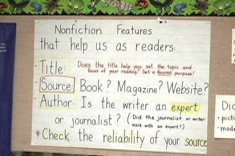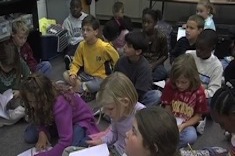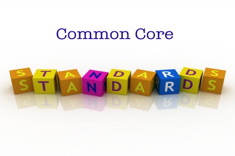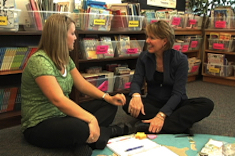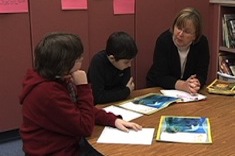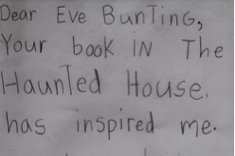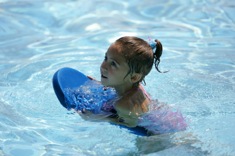Articles
Here is where you’ll find all the latest print features from our contributors. If you’d like to browse specifically by grade level, topic, or contributor, you can use the links in the right sidebar.
Latest Content
The Apple Doesn’t Fall from the Tree: Nurturing Critical Thinking and Choice with Middle School Writers
Katie Baydo-Reed has to try, try, and try again to get high quality writing and thinking from her eighth graders, but the effort builds independence and reflection.
What Anchor Charts Are Essential?
Katherine Sokolowski considers what anchor charts are essential in her fifth-grade classroom, and where they work best for posting.
Ten Things Every Writer Needs to Know: A Podcast with Jeff Anderson
Jeff Anderson shares some insights from his latest book in this new podcast hosted by Franki Sibberson.
Make a Really BIG List
Big lists can be intimidating, especially when our to-do lists are long and never quite finished. Ruth Ayres explains the power of big lists in other contexts, especially writing, and how they might actually provide comfort and security when tackling big projects and ideas.
Ten Classic Ideas That Still Work
Teachers are always on the hunt for something new, even as we cherish what works well year after year. Franki Sibberson lists the activities that have stood the test of time in her classroom.
Between Inquiry and Instruction (Conventions Series Part 3)
Heather Rader works with a team of intermediate teachers as they pore over student work together and analyze which conventions should be taught.
What Matters? Teaching Conventions Series
Heather Rader works with a team of intermediate teachers to ferret out what does and doesn’t work, based on research and experience.
Good News: Your Teacher is Calling
Heather Rader and Jennifer Taft share strategies for positive communication with parents.
Book Memories
Jennifer Schwanke finds connections between her childhood, teaching, and school leadership in this heartwarming essay.
Opening Doors to Parents in Middle School
Gretchen Taylor finds middle school parents enjoy hearing about their child’s day — it’s just a matter of getting creative in dealing with the large number of families.
Concise, Conversational, and Consistent: Explaining the Work of Literacy Coaches
Heather Rader shares the language she uses to describe literacy coaching to others.
Finding a Fit (The Power of Conventions Series)
Heather Rader works with a teaching team as they integrate conventions instruction into their writing workshop.
From Reading to Writing Informational Texts
Aimee Buckner makes some surprising discoveries about what types of texts support writers working in nonfiction genres.
Trust
Mary Lee Hahn reminds herself (and us!) of the qualities we have that inspire trust in ourselves and our ability to teach well.
Unpacking the Kindergarten Common Core Standards
Mandy Robek shares five tips that can help teachers at any grade level develop strategies for tackling the Common Core.
Supporting Young Writers with Opinion Texts
Katie DiCesare considers how different texts at the primary level can support student understanding of standards for opinion and argumentative writing.
Chronology in Nonfiction (Common Core Booklist)
Franki Sibberson's latest Common Core booklist includes texts to help students master chronology in nonfiction.
Shifting from Spelling to Word Study in 5th Grade
Maria Caplin explains how she made the shift from spelling to word study in the intermediate grades.
The Joys and Challenges of Co-Teaching
Katherine Sokolowski explores the challenges and joys of co-teaching with special education colleagues.
Do They Care? Empathy Book Clubs
Do they care? That’s the question Karen Terlecky asks herself as she sets up book clubs in her fifth-grade classroom with a focus on empathy.
The Blank Page and Better Teaching
Aimee Buckner learns some important lessons about how images and words work together for student writers when she moves between second- and fifth-grade classrooms.
Revising My Recording Form for Writing Conferences
Mandy Robek shares how she has revised the records she keeps during writing conferences.
Appealing Book Displays for Boys
Are your book displays enticing to the boys in your classroom? Tony Keefer has suggestions for making classroom libraries more appealing.
On Perfection and Goals
Ruth Ayres explains how she sets realistic goals for her own learning during the year.
Without Answers
English language learners may have some of the quietest voices in schools. In this poem and narrative, Stella Villalba shares the power of finding ways to bring those voices out in your classroom.
Dear Eve Bunting
A persistent seven-year-old has some powerful messages about confidence, patience, and sending writing out into the world.
The Power of Music
What can music add to the classroom? Plenty! Sean Moore and Heather Rader provide many examples and favorite tunes.
Enhancing Read Aloud and Eliminating Notebook Clutter
Melissa Styger has some simple suggestions for streamlining and improving student-written responses to read alouds.
Interactive Read Alouds to Support Struggling Readers
Shari Frost explains how interactive read alouds are the “kickboards” of reading instruction, especially for struggling readers. She explains how one teacher used them to support a struggling reader in 3rd grade.
When Are Students Ready for Writers’ Notebooks?
Second grade? Third grade? Aimee Buckner breaks down what behaviors to look for if you’re trying to determine when students are ready to move from draft pages or booklets to writers’ notebooks.
Browse Content By
Type
Category
- Assessment Tools
- Big Fresh Archives
- Booklists
- Choice Numeracy
- Classroom Design
- Common Core
- Community Building
- Conferring
- Content Literacy
- Digital Literacy
- English Language Learners
- Equity
- Family Relations
- Free Samples
- Guiding Groups
- Leadership
- Literacy Coaches
- Mentor Texts
- Minilessons
- New Teacher Mentors
- Podcasts
- Poetry
- Quote Collections
- Reading Strategies
- Self Care
- Struggling and Striving Learners
- Talking and Listening
- Teacher Study Groups
- Teaching Reading
- Teaching Writing
- Word Study and Vocabulary
Author
- Melissa Quimby
- Nawal Qarooni
- Gwen Blumberg
- Julie Cox
- The Lead Learners
- Hannah Tills
- Josie Stewart
- Ruth Metcalfe
- Mallory Messenger
- Becca Burk
- Jodie Bailey
- Vivian Chen
- Mary Brower
- Tiffany Abbott Fuller
- Stephanie Affinito
- Ruth Ayres
- Leigh Anne Eck
- Heather Fisher
- Shari Frost
- Julie Johnson
- Suzy Kaback
- Gigi McAllister
- Shirl McPhillips
- Melanie Meehan
- Cathy Mere
- Debbie Miller
- Tara Barnett and Kate Mills
- Tammy Mulligan
- Dana Murphy
- Bitsy Parks
- David Pittman
- Brenda Power
- Heather Rader
- Matt Renwick
- Mandy Robek
- Christy Rush-Levine
- Gretchen Schroeder
- Jen Schwanke
- Brian Sepe
- Katherine Sokolowski
- Stella Villalba
- Jennifer Vincent
Grade Level
Choice Literacy Membership
Articles
Get full access to all Choice Literacy article content
Videos
Get full access to all Choice Literacy video content
Courses
Access Choice Literacy course curriculum and training


